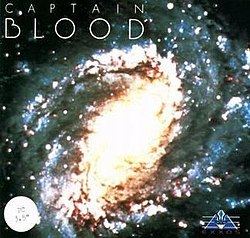9.6 /10 1 Votes9.6
Distributor(s) Mindscape (US) | 4.8/5 My Abandonware Release date(s) 1988 Initial release date 1988 Genres Adventure, Simulation | |||||||||||||||||||||||||||||||||
 | ||||||||||||||||||||||||||||||||||
Designers Didier Bouchon, Phillipe Ulrich Similar ERE Informatique games, Adventure games | ||||||||||||||||||||||||||||||||||
Captain Blood (L’Arche du Captain Blood in France) is the name of a French video game from 1988 made by ERE Informatique (soon relabeled with their short-lived Exxos label) and released by Infogrames. It was later re-released in the UK by Players Premier Software. The title tune is a stripped down version of "Ethnicolor" by Jean Michel Jarre.
Contents
Development
Captain Blood was developed jointly by Didier Bouchon and Philippe Ulrich, both contributing design and scenario, and Bouchon graphics and programming for the Atari ST version. Bouchon originally designed covers for ERE informatique's Gazoline Software label, but he learned to program in assembler for the Atari ST after Ulrich provided him with one. Bouchon then created fractal-generated realtime graphics that inspired both to do a sci-fi inspired video game.
After ERE's absorption by Infogrames in summer of 1987 (partly justified by preliminary versions of Captain Blood), Ulrich and Bouchon isolated themselves in the Landes in order to have the game ready for Christmas. Many adaptations for both 16-bit and 8-bit machines were developed in successive months, although they were straight ports of the original Atari ST version in graphics, sound effects or music, and therefore follow the limitations of that machine.
Storyline
The titular character of the game is a 1980s video game designer, Bob Morlock, who had picked "Captain Blood" as a nickname in tribute to the film starring Errol Flynn of the same name. Morlock develops a new video game about aliens and space travel. While testing for the first time his new project, he becomes warped inside the spaceship of the very game he had designed. Soon after, Blood is forced to go into hyperspace mode and, due to an incident, gets accidentally cloned 30 times. For 800 years, Blood tracks down every clone, as each one took a portion of his vital fluid. When the game begins, Blood successfully disintegrated 25 clones but he needs to kill the last five clones who turned out to be the most difficult to track down or he will lose his last connections with the human species.
Gameplay
The objective of the game is to track down and disintegrate five clones (referred to as Duplicates or Numbers depending on the version of the game) of Captain Blood. To find them, the player must speak to various aliens and gain their trust. Communication with aliens occurs via an icon-based interface known as UPCOM. This consists of around 150 icons, each representing a different concept. As each alien race discovered speaks its own language and reacts differently, the player must learn to negotiate using these UPCOM concepts in a style that suits the races.
Other unique facets of the game play of Captain Blood included changes in the player interface as the game progressed; as time wore on, the character's health deteriorated. This was represented in-game via an increasing amount of shaking of the mouse cursor, making the game more and more difficult to control. Disintegrating a clone would temporarily relieve the symptoms.
The player starts the game at the bridge of a biological ship, the Ark. The ship begins in the vicinity of one of four predetermined planets, each inhabited by a single alien. To make contact with an alien, the player launches an OORXX - a biological probe - to the planet's surface. The player must successfully navigate the probe over a fractal landscape, eventually reaching the alien at the end of a valley. The UPCOM interface then appears so that the player may talk to the alien and find out more information—most importantly, the coordinates of other inhabited planets.
The Ark also has the capability to hyperspace to other planets, scan planets for defences, destroy planets and teleport aliens to an area known as the Fridgitorium, for disintegration or transportation to another planet. An alien can only be teleported to the Ark after it has consented to do so.
Versions
The game was first released on the Atari ST, and was later released on the C64, Macintosh, Amiga, Apple IIGS, PC and many 8-bit platforms, including the ZX Spectrum. The ST version is the only version that includes the full set of alien language sounds.
Sequels
It was followed by the sequel Commander Blood in 1994 and later by Big Bug Bang in 1997, a French-only release.
Reception
Computer Gaming World gave the game a positive review for its unusual concept, execution, and graphics. Orson Scott Card praised Captain Blood's EGA graphics and science-fiction story, but wrote in Compute! that "as a game, this one sucks pond scum", citing a poor interface and obscure game play. Info magazine—January/February 1989—gave the game 5 out of 5 stars, remarking: "Captain Blood is a marvelously alien experience. The graphics & sound are first rate. The more we played, the more we wanted to continue playing, if only to meet more aliens. There is a fully realized universe here that's easy to become completely immersed in."
